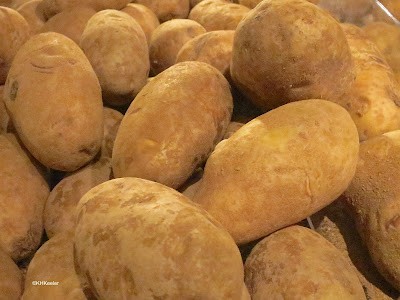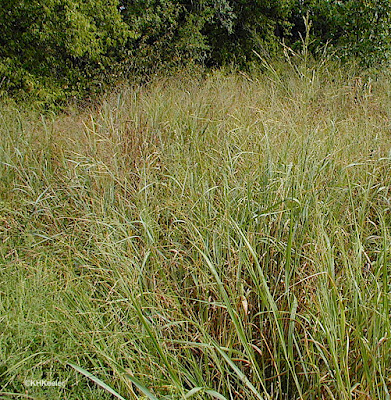Polyploidy is whole genome duplication, a genetic phenomenon which is widespread in plants and uncommon in animals. The ancestry of most if not all plants includes a doubling of all the chromosomes. In addition, many plant species were formed by crossing between two existing species, with subsequent doubling of the genome which made the hybrid fertile. (See previous blogs Intro to Polyploidy, Crop Plant Polyploidy, Speciation via Polyploidy).
Long known and still poorly understood is variation in polyploidy within a species.
 |
| fireweed (Chamerion) has within-species polyploidy |
Polyploidy where the sources of the chromosomes are two different species is called allopolyploidy (allo- from “different”). But polyploidy can occur by simply doubling all the chromosomes of a plant cell, without hybridization, as appears to be the case of potatoes, Solanum tuberosum, which are tetraploid (4x). Usually this is ascribed to some kind of cell division failure. If a plant derived from that failure survives, it has undergone whole genome duplication and is polyploid compared to its parents. This kind of polyploidy is called autopolyploidy (auto- for “same” or “self”).
 |
| Solanum tuberosum, potatoes, autotetraploid (4x) |
Allopolyploids generally look different from their parents and, although not conspicuous, can be spotted by botanists. Autopolyploids are generally cryptic, maybe a little bigger than their parents but, since they simply have twice the same chromosomes as their parents, very similar.
Looking at and counting chromosomes with a microscope, the definitive method, has always been a meticulous process that takes some hours, so it is not done lightly. Thus, chromosomes were usually counted for two or three plants per species and then the botanist moved on to something new. Only very occasionally did someone look at more plants per species. Sometimes they found multiple polyploid levels in plants growing close together.
My favorite last century study is Analysis of variation in Panicum virgatum by E. L. Nielsen (1944). He in a common garden he grew Panicum virgatum, switchgrass, plants from populations where plants of multiple ploidy levels were growing together--chromosome numbers, 18, 36 and 54 (diploid, tetraploid and hexaploid) at his biggest site. He measured and compared. He found some characters that differed between ploidy levels and some where they did not. Nothing that led him to conclude there were two races or cryptic species present. (Across its range--most of North America--switchgrass plants were found with 2x, 3x, 4x, 6x, 8x and 10x chromosome counts, often at least three levels growing together.)
 |
| Panicum virgatum, switchgrass, a species with several polyploid levels |
This century, flow cytometry and genetic markers have made screening large numbers of wild plants for ploidy level feasible and we find more and more autopolyploidy within populations. For example the important prairie grasses big bluestem Andropogon gerardi and buffalo grass (Bouteloua dactyloides/ Buchlöe dactyloides), have infraspecific autopolyploidy, but so does western spring beauty (Claytonia perfoliata), fireweed (Chamaerion angustifolium), and yarrow (Achillea). The more we look, the more we find. These are plants that are growing together, usually cross-pollinate, and are of very different chromosome numbers. It is as if chromosome number were no more important than blue flowers versus white flowers.
(I chose the flower color example on purpose. Flower color can be important, but is nevertheless rarely the sole criterion for separating two plants as being in different species.)
Biologists would like different levels of polyploidy to be different species, but that does not work for many important species, where polyploids within a population are more like each other than plants from other populations, so apparently interbreed. They call it a polyploid complex or a species complex and continue to look for patterns. I’ll write about those in the future.
 |
| yarrow, Achillea millefolium, a polyploid complex |
The data are clear: the number of copies of the genome is a genetic characteristic of plants that is very variable, between and within species. Thus, plant species can be diploid, with only one copy of the genome (corn, Zea mays). They can be allopolyploid with multiple copies of a genome derived from two different ancestral species (bread wheat, Triticum aestivum). They can be autopolyploid, with more than two copies of the same genome (potatoes Solanum tuberosum). Plant species can be uniform for chromosome number or contain individuals with chromosome numbers that form a polyploid series (switchgrass, Panicum virgatum). (They can also have chromosome numbers that are not simple multiples. That for later). What this means is still emerging. But the bottom line is that polyploidy is a plant characteristic that can be very different between species or individuals.
We are not sure what-all polyploid variation does, but at minimum, it changes inheritance patterns. (See notes at bottom of previous blog: Polyploidy in Crop Plants.)
Comments and corrections welcome.
What I haven’t covered and hope to get to are these topics: how polyploidy affects inheritance; how polyploid complexes within species affect fertility; patterns of adaptation to environment by autopolyploids.
Note: Recent scrutiny has determined that the species epithet of Andropogon gerardi has only one i. As I understand it, genitive (possessive) in Latin after a consonant on a nonLatin word requires 2 i's. Vitman, who named it, used only 1 i and people after him "fixed" it. However, Gerard is one of a few names considered already in Latin (link). So A. gerardi is correct. The literature will eventually catch up. (And all my publications have it misspelled. Alas!)
References
Hadle, J.J., F. L. Russell, and J. B. Beck. 2019. Are buffalograss (Buchloë dactyloides) cytotypes spatially and ecologically differentiated? American Journal of Botany. 106: 1116-1125. link (Accessed 4/25/24)
Husband, B.C. and H. A. Sabara. 2003. Reproductive isolate between autotetraploids and their diploid progenitors in fireweed Chamerion angustifolium (Onagraceae). New Phytologist. 161: 703-713. link (Accessed 4/25/24)
Keeler, K. H. 1990. Distribution of polyploid polymorphism in big bluestem (Andropogon gerardii) across the tallgrass prairie region. Genome. 33: 95-100.
McAlister, C., R. Blaine and 7 others. 2015. Environmental correlates of cytotype distribution in Andropogon gerardii (Poaceae) American Journal of Botany. 102 (1): 92-102. link (Accessed 4/25/24)
McIntyre, P. J. 2012. Cytography and genome size variation in the Claytonia perfoliata (Portulacaceae) polyploid complex. Annals of Botany. 110: 11951203. link (Accessed 4/25/24)
Nielsen, E. L. 1944. Analysis of variation in Panicum virgatum. Journal of Agricultural Research (Washington, D.C.) 69: 327-353. (link This is the whole journal, the search taking you to the middle of the article). (Accessed 4/26/24)
Ramsey, J. and D. Futuyma. 2011. Polyploidy and ecological adaptation in wild yarrow. Proceedings of the National Academy of Sciences of the United States of America. 108: 7096-7101. link (Accessed 4/25/24).
Sun, H., W-B. Jiao and 7 others. 2022. Chromosome-scale and haplotype-resolved genome assembly of a tetraploid potato cultivar Nature Genetics. 54: 342-348 link (Accessed 4/26/24)
Thanks once again for the polyploidy posts. I look forward to more, especially about roles in evolution, adaptation.
ReplyDelete